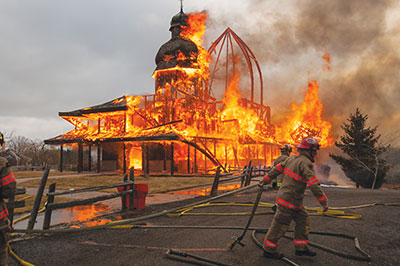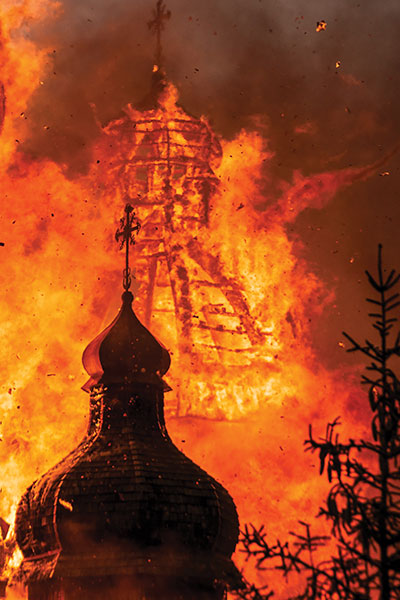
Features
Hot topics
Incident reports
Incident Report: June 2014
In the early hours of Friday, April 4, a caretaker sleeping in his
third-floor room at the St. Elias Church in Brampton, Ont., awoke to the
smell of smoke.
June 2, 2014
By Michael Clark
In the early hours of Friday, April 4, a caretaker sleeping in his third-floor room at the St. Elias Church in Brampton, Ont., awoke to the smell of smoke. The caretaker was alone in the building at the time and when he investigated, he found smoke in the basement closet, and the alarm bells were now ringing. At 06:49, the caretaker’s phone call was received at the Peel Joint Fire Communications Centre.
 |
|
| Brampton Fire and Emergency Services responded early on April 4 to a fire at a church in a rural region that is not serviced by hydrants. The structure was made of heavy Douglas fir timbers, was not sprinklered and had only two dry hydrants that were supplied by a long draft from a small frozen pond behind the building. Photos by Michael Maniezzot
|
At 06:50, the initial alarm of Pumper 210, Pumper 204, Pumper 212, Aerial 204, Pumper 205, Car 208 (the district chief), and Car 206 (the platoon chief) from Brampton Fire and Emergency Services were dispatched to a commercial structure fire at 10193 Heritage Rd. – St. Elias Church.
St. Elias Church was a Ukrainian church built in the countryside in the northwest area of Brampton. The church was built in 1995 of heavy Douglas fir timbers and had a footprint of about 12 metres by 24 metres (40 feet by 80 feet). The five cupolas (roof domes) were built in the 17th century Cossack Baroque style, and were sheathed in Western redcedar. The interior of the building was ornately decorated with paintings and religious objects, in keeping with Ukrainian tradition. The building was not sprinklered and had only two dry hydrants that were supplied by a long draft from a small frozen pond behind the building.
The wind was out of the west at 40 kilometres per hour (km/h) gusting to 60 km/h. The temperature was -2 C, and it was snowing.
The crews on the way – through their pre-planning – were very familiar with the challenges that this building posed. While en route, they strategized the tactics that they would shortly employ. The Pumper 210 captain recognized that the building was not serviced by a municipal hydrant and requested a tanker dispatch. At 06:53, the communications operator dispatched Pumper 209 and Tanker 209.
 |
|
| The fire at St. Elias Church demonstrated the value of effective pre-planning and the need for a well-developed water shuttle plan. The incident commander took assertive steps to lay out his action plan while still en route but the limited water supply was no match for the large, well-involved, combustible structure. |
When Pumper 210 arrived at 06:58, the captain staged his vehicle in front of one of the dry hydrants and reported that there was nothing showing. Recognizing the inherent difficulty of achieving and maintaining a draft from the frozen pond, the captain established a back-up water supply. He ordered that Pumper 204 and Aerial 204 stage on the church property and had Pumper 212 lay in its hi-vol (100 millimetre) hose to establish a relay from the porta-tank, which would arrive with the tanker. Pumper 205 arrived and established a rapid intervention team.
In front of the building, the Pumper 210 captain was met by the caretaker, who explained the situation. The captain updated the communications centre that there was a working fire in the basement and requested two additional tankers, employing mutual aid from Caledon Fire and Emergency Services.
The Pumper 210 crew stretched a 90 mm attack line to make the long route to the basement. The Pumper 204 crew was assigned as rescue sector. Upon entering the building, the Pumper 210 crew found no smoke. Once crew members made it to the basement closet, they found smoke but no fire; they heard a bang and debris falling, and concluded that the fire was above them. The bang was later suspected to be a flashover. The crew moved to the outside of the building and around to the Charlie side, where they found heavy fire blowing horizontally from a window and licking up the wooden cladding. A second alarm was requested. At 07:04, Squad 205, Aerial 208, Squad 201, Aerial 207, Pumper 201, Car 207 (district chief), Air/Light 201 and Rehab 201 were dispatched to the fire.
The Pumper 210 captain ordered that water be applied to the rapidly spreading fire. By 07:10, the loss of the structure became apparent, and the main concern became the safety of the firefighters. By 07:25, the fire – driven by the strong winds – had broken through the roof. At 07:29, the evacuation tones were sounded. By 08:03, the wooden structure had began to collapse. Crews continued to work on the scene for another four hours. Tragically, this large wooden structure, with its limited water supply, was doomed early into this fire to utter destruction.
This fire demonstrated the value of effective pre-planning and the need for a well-developed water shuttle plan. In this incident, the incident commander took assertive steps to lay out his action plan while still en route.
DEPARTMENT PROFILE
Brampton Fire and Emergency Services
- 12 full-time fire stations
- 18 frontline vehicles
- 464 employees
- 265 square kilometres
- Approximately 600,000 residents
- 18,110 calls in 2013
Michael Clark has been a member of Brampton Fire and Emergency Services for 32 years. He is currently a deputy chief overseeing the 398 men and women in the firefighting and training divisions.
Print this page